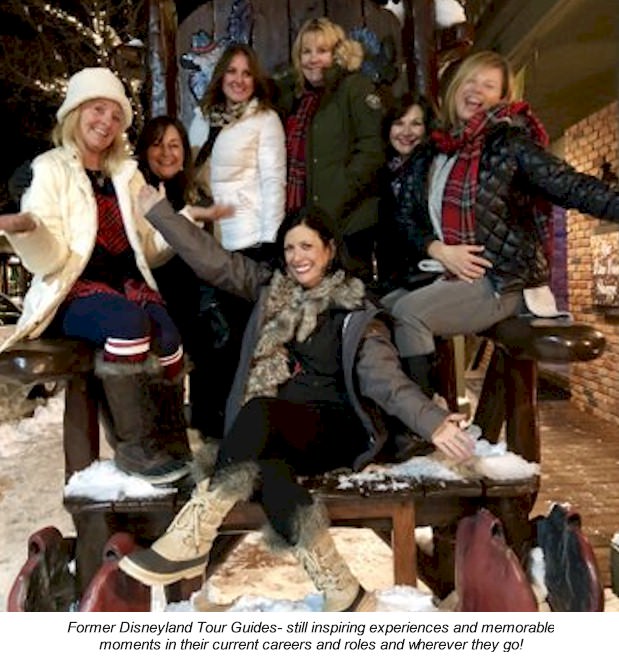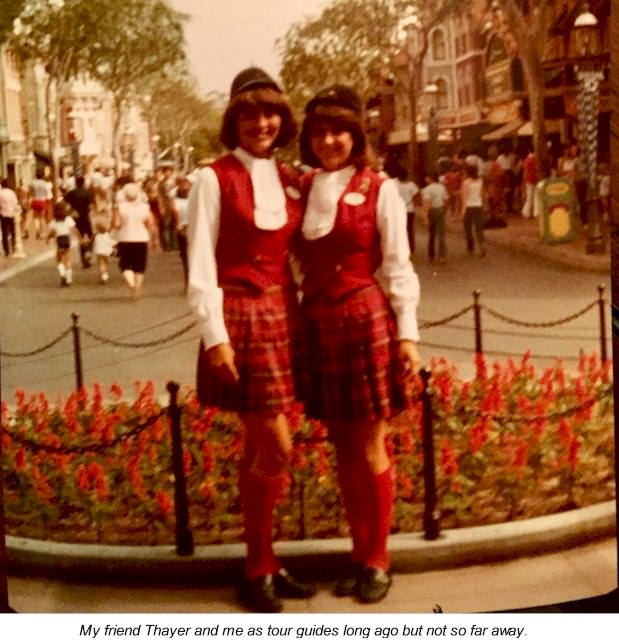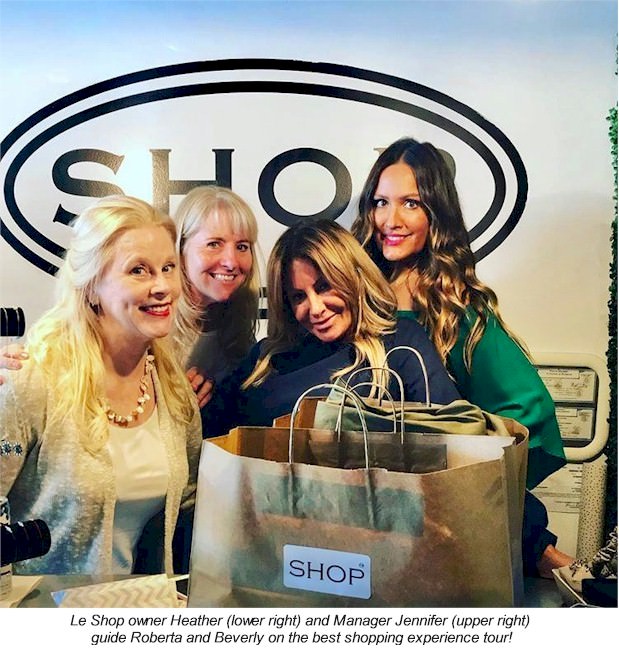By Roberta Nedry
Sometimes I just can’t help myself! I see a darling couple, standing on the restaurant dock, taking photos of each other. I must leave my own meal and partner to offer to take a photo of them together. I just have to jump in and make sure their experience is as wonderful as it can be, even when I am not on duty. Or, no matter what state or country I am in, I seem to be the person people stop in airports or on the streets to ask directions or to ask for information I don’t even know. And, whether it is a tour of my country, my state, my town, my neighborhood, my house or even my kitchen, I must make sure my audience (whether they want to or not) does not miss anything or any moment that might make their day or experience more memorable.
Once a tour guide, always a tour guide and I trained with some of the best. Thanks to the exceptional Guest Relations team at Disneyland and Walt Disney’s desire for complete sensory engagement, this proactive experiential model and ‘tour guide’ standard I experienced from an early age inspires the mission and philosophy of my business today.
As I reflect on the incredible Tour Guide ‘Cast” members that I worked with, their personal standards of service delivery and commitment to emotional engagement at every touchpoint are applicable in any industry or business setting today. Going beyond the obvious guided tour, mobilizing a ‘guided tour’ strategy that zeros in on each step or moment in a customer’s journey can be a powerful training concept to deploy at every level of an organization.
Consider how a Guided Tour experience works and how that applies to orienting and training employees. First a tour guide candidate must learn the landscape of the ‘tour’ they’ll be giving. They must not only know the facts and details but why the tour is important. They must learn the history of what they’ll be guiding and the stories and nuances that will make the tour come alive.
What are the opportunities for hospitality leaders to take customers on a guided tour of daily business activities?
How can employees make each stop more meaningful, more memorable or more interesting?
What can they say or do within the scope of their own duties, their own actions, their own responsibilities to guide each guest to a more fulfilling result?
And, as the guest or customer interacts with different employees during their experience, how is the baton passed so that the ‘tour’ continues seamlessly and with the same level of engagement and interest?
How does making an emotional connection become the Guiding philosophy of each step of the service delivery ‘tour?’
When we showed up for work (our role) as a Disneyland Tour Guide each day, we put on our Tartan Plaid uniforms (costumes), stepped ‘on stage’ and lined up to get our assigned tour groups. We arrived excited and already engaged because of our training as well as the expectations set for this role and our costumes inspired our mindsets even more. We had a script to follow but we constantly adapted and improvised depending on the personalities, cultures and reactions of the group. Every tour was different, and every group responded in different ways. That made it more fun for us as the experience was dynamic and based upon our abilities to proactively guide, channel and ignite interest and emotions to make the magic of Disney come alive. Let’s look at your service crew experience:
1. How excited or engaged are your employees when they show up to work each day? What would make the positive difference? Just like athletes warm up before they game, what are your employees doing to warm up before starting their tour or their job roles? What are managers and supervisors doing to inspire good starts to the tour?
2. What standards have been established BEFORE your employees show up to work? What are their mindsets for delivering that day’s experience? How will they guide their own behaviors so that the guest benefits on the tour?
3. How well do they know their ‘script’ for their role and how to manage flexibility and interactions during their ‘tour’ or their individual responsibilities?
4. Are they empowered to improvise or respond to unexpected good or poor moments? A good “tour” is not robotic or rehearsed. A good tour is personal and authentic.
5. How do they ensure that the tour moves seamlessly from one guide or employee to the next? How will they make sure the experience comes alive for each guest, even if it’s something as simple as checking a guest in or out? How does that moment on the tour become meaningful even during that short stop?
Recently a visit to a major sports and concert entertainment venue resulted in a tour gone awry and several of the tour points noted above not in play. The experience started out great. The sales team had done a magnificent job of enticing us to check out the venue with the goal of having us purchase a season commitment to the venue. The beginning of the tour was great; the phone calls to get us there, the signage, the parking, the welcome, the entrance, the initial walk-around were all fabulous. Then, the tour seemed to STOP midway.
Our exciting sales reps (our initial tour guides) left us to experience the venue and entertainment alone for the rest of the night. Unfortunately, the ‘guides’ they passed us on to did not recognize the ‘major potential financial commitment’ tour we were on. Drinks at the bar were expensive and incomplete. Only certain ingredients were available and even the cherries were missing. They did provide some small snacks, but they did not fit the high-quality tour experience described to us and ran out quickly.
What started out as the full package ‘tour’ turned into the ‘do it yourself’ tour which we were not expecting. Our bartender ‘guides’ seemed uninterested and uniformed. One even misunderstood we were guests of the sales team and blocked us from getting back to the area we were invited to, making us feel like we’d been kicked off the tour. Bathroom lines were long and inefficiently organized. Questions about the entertainment could not be answered thoroughly by many employees (they did not KNOW their tour script) and when we wanted a hamburger cut in half, so we could share it without all the messiness, it took over 20 minutes for any one employee to figure out how to do that.
Each of these tour stops turned into detours instead of the next stop. With the tour not going well we contacted our original guides and though they apologized, the bumpy tour stops were not addressed, and we left thinking that was a tour we did not want to repeat again nor recommend to others. The guided tour is a metaphor for the service touchpoint continuum. In this case, the tour was discontinued at several touchpoints along the way. We determined that making a commitment to this venue, so we could conduct our own tours and invite our own guests was a risky investment which could leave our guests feeling alienated.
On the other hand, when a tour makes you smile during every part, the result is fantastic…and profitable. Thanks to a dear friend, I was introduced to a small boutique in Haddon Township in the suburbs of New Jersey. Le Shop Owner, Heather Hohweiler, really knows how to deliver service glee as part of her guided tour of the shopping experience and makes sure she knows who will be on her ‘tour’ in advance. From the amazing welcome and focus on our individual styles to her advance prep to get our favorite beverage accented by black and white straws, she had scripted out ways to engage us before we even got to the clothing.
She made it fun, interactive, relaxed and personal to our needs and showed us things we might not have considered without her guided influence. The shop setting was small and cozy, but our experience was big and thoughtful. Her merchandise was comfortable and reasonable yet in tune with the latest fashion season colors and styles. I found myself continually adding new things to try on as I did not want my experience, my tour, to end. And adapting a ‘tour guide’ philosophy paid off as I left with at least 10 articles of clothing instead of my planned two! And, Heather makes sure to change up her tours to keep her customers engaged and coming back and understands connecting with each customer’s own style and preferences.
If something was not available that a customer wants, Heather would find it and add it to the ‘tour.’ Whether it be a Kentucky Derby party, the Royal Wedding or a customer’s personal celebration of any kind, Heather is prepared to tie in to current events and make it a fun tour involving her merchandise and shop experience. She knows how to involve spouses and partners on the tour too, so no one is left out of the experience. One customer noted that being in Le Shop “felt like being somewhere where you knew people for years.” She makes sure her tours stay relevant and visible by constantly posting new fashions, style ideas and applications on social media. Her following is HUGE and her shop always busy. Le Shop is one of the most popular tours in town and an experience that books up fast with repeat business,referrals and loyal customers.
And don’t kid yourself, this strategy works in places large and small. It works on the front line and behind the scenes with every link in the guest experience. If you are not serving the customer, you are serving someone who is so be prepared to jump into your tour stop whether you are supporting a customer or an employee. This guiding tour strategy is also essential with all internal audiences and employees. When I worked with the tour guide team, we always lifted up each other and made our ‘behind the scenes’ tour moments meaningful too. We feel our best and deliver our best when others treat us with their best. In fact, every leader in your organization should consider themselves a guide for showing the members of the team how to create the best experiences. This tour guide approach comes full circle when embraced and leads to destinations in service excellence.
In fact, anyone who has traveled internationally and experienced the attention of a professional tour guide knows that your entire impression of a country or landmark can be completely designed by an effective "guiding" strategy.
The Service TouchPoint continuum is a powerful strategy for any industry or any business. The metaphor of taking customers and guests on a ‘tour’ makes any experience come alive and guides that customer to best options for them. Adopt a Tour Guide philosophy and approach to the Guest Experience no matter what role you have or where you jump into the experience. Orient your mind to be ready for anything along the tour, at each point of contact. Make sure everyone involved in guiding the ‘tour’ is as tuned in as you are to ensure each guest is engaged and emotionally connected to the experience that is underway. Each role, each guide should be able to anticipate, set and react to expectations that evolve in the tour journey.
Following the examples set by some of the best tour guides will find result in a bounty of customer loyalty, word of mouth referrals, positive reviews and of course enhanced profits.
Be the one that jumps in when guests are on your tour and create snapshots of service excellence! Make sure your audience, your tour participants, don’t miss a moment and make sure the ones they have are meaningful and positively memorable at every stop and during all seasons.
Reprinted from the Hotel Business Review with permission from www.HotelExecutive.com.




